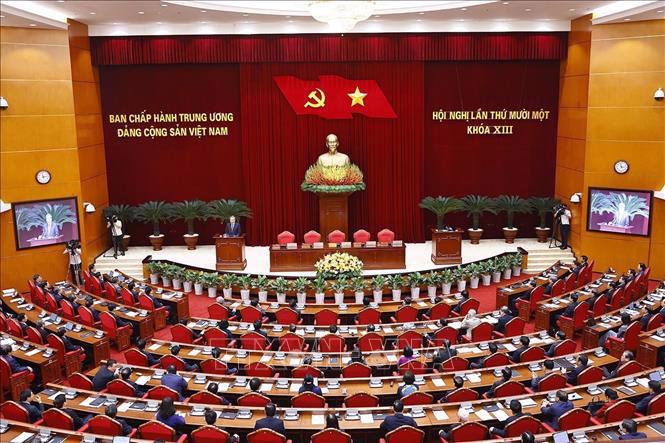The 11th plenum of the 13th Party Central Committee concluded on April 12 afternoon after three days of sitting, reaching agreement on proposals concerning the continued restructuring of the political system’s organizational apparatus, rearranging administrative units and organizing local administrations with provincial and communal levels, according to the Vietnam News Agency.
Party General Secretary To Lam was quoted by the news agency as saying at the closing session of the plenum that members of the Party Central Committee discussed many new and important matters, and reached high consensus on major and core issues, culminating in a unanimous vote to adopt the plenum's resolution.
Many members proposed the Politburo recognize the session as a historic one, marking a turning point with bold decisions for the country’s new phase of revolutionary development, he said.
The Party chief praised the committee’s proactive, scientific, and efficient work attitude, as well as the thorough and focused preparations carried out by sub-committees and relevant agencies.
He said that the Party Central Committee reached broad agreement on proposals concerning the continued restructuring of the political system’s organizational apparatus, rearranging administrative units and organizing local administrations with provincial and communal levels. Under the new model, the country will comprise 34 provincial-level units (28 provinces and six centrally-run cities), with specific names and administrative centers determined according to the outlined principles.
The dissolution of district-level administrative units will be conducted, pending the National Assembly’s revision of the 2013 Constitution and the 2025 Law on Local Government Organization. Commune-level units will be merged to reduce their overall number by around 60–70%.
The Party leader affirmed the support for aligning local Party structures with the new administrative levels - province and commune - while disbanding district-level Party organizations in accordance with the Party's Charter and regulations.
Following the new structure, provinces will both implement central policies and issue provincial/municipal policies. They will also directly oversee commune-level activities. Communes, meanwhile, will execute policies handed down from the central and provincial levels, while gaining more autonomy to issue local legal documents, organize law enforcement as well as decide issues within their authority.
The Party leader also gave the green light to merge and streamline the Vietnam Fatherland Front committees, socio-political organizations, and mass associations across all levels. This includes disbanding unions for civil servants and armed forces, and reducing union fee contributions for workers and employees.
The Party Central Committee agreed on restructuring the People’s Courts and People’s Procuracies. The district and high-level courts/procuracies will be dissolved, replaced by a three-level system -the Supreme People’s Court/Procuracy, provincial/municipal and regional courts/procuracies. The structure of military courts and procuracies remains unchanged.
It also reached consensus on amendments to the Constitution and relevant laws, which must be finalized by June 30, and come into effect from July 1, with provisions on transitional period to ensure continuity and alignment with the reorganization roadmap.
General Secretary Lam underlined that the National Assembly, Government, and relevant bodies must work closely and efficiently to carry out institutional reforms. The goal is to remove legal and procedural bottlenecks, especially in public procurement, budgeting, public investment, private sector development, science and technology, innovation, and digital transformation, facilitating the revolution on organizational apparatus.
He also emphasized the need to foster a legal environment that is transparent, safe, and low-cost, while turning institutional obstacles into competitive advantages to help position Vietnam as a regional leader in administrative reform and innovation.
The plenum also discussed and reached agreement on many issues relating to the preparation for the upcoming 14th National Congress of the Party.









 Google translate
Google translate